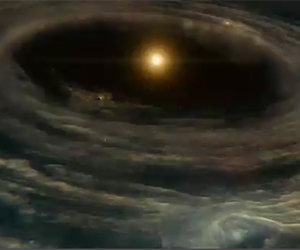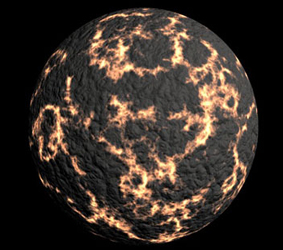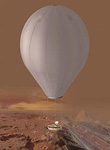| Quick astronomy guide to the planets, sun and moons of our solar system |
Our Solar System
|
< The Outer System
|
Kuiper Belt Object - Deep Impact
Neptune's Moon Triton - Voyager 2
Outer System Facts
Objects orbiting in the Kuiper Belt and Oort Cloud are mainly composed of ice, ammonia and methane.
The dwarf planets Pluto, Eris, MakeMake and Huaumea all orbit in the Kuiper Belt.
There are thought to be at least 70,000 objects in the Kuiper Belt with a diameter over 62 miles (100 km).
Neptune's moon Triton is thought to have originally been a Kuiper Belt Object (KBO) that was captured by the planet's gravity. (See image left)
The Kuiper Belt is named after the Dutch astronomer Garard Kuiper.
There are possibly 2 trillion icy bodies in the Oort Cloud.
The Oort Cloud extends so far it almost reaches half way to the nearest star Proxima Centauri!
Objects found in the Oort Cloud are believed to be remnants from the early formation of the solar system that were thrown far into space by
by the gravity of the giant planets.
The Oort Cloud is named after another Dutch astronomer Jan Hendrik Oort.
The Kuiper Belt
The Kuiper Belt is located at around 2.8 billion miles (4.5 billion km) from the sun and extends for 1.9 billion miles (3 billion km). It is similar to the asteroid belt except
it is around 20 times larger, and instead of containing rocks the objects found here are composed of methane, ammonia and ice.
The Oort Cloud
The Oort Cloud begins at 750 billion km from the sun and ends at the very edge of our solar system, almost 2 light years from the sun. It is a massive spherical cloud
containing billions of icy bodies. Occasionally these bodies get knocked out of their orbit and enter the inner solar system, they then become comets. Although some comets originate
from the Kuiper Belt most come from the Oort Cloud.
| Comets |
Comets are icy bodies from the Kuiper Belt and Oort Cloud which enter the inner solar system. Comets originating from the Kuiper belt have short orbital periods below 200 years, bodies from the Oort Cloud have orbits ranging from 200 years up to millions of years. When these icy objects enter the inner solar system the effects of solar winds and radiation vaporises the ice creating a thin atmosphere around them known as a coma, occasionally they will also develop a tail.
It is believed that the gravitational pull of the outer planets bring bodies from the Kuiper Belt into the inner solar system. Objects in the Oort Cloud are effected by giant molecular clouds or passing stars that can nudge them out of their orbit. As comets cross the orbital paths of planets they do occasionally collide with them, as was the case in 1994 when fragments of Comet Shoemaker-Levy 9 hit Jupiter.
| Missions to Pluto |
New Horizons
 Launch: January 2006
Launch: January 2006Arrival: July 2015
Agency: NASA
NASA launched New Horizons in January 2006 thus taking advantage of a once in a life time chance to use Jupiter as a gravity assist towards Pluto. It should arrive at Pluto in July 2015 thus becoming the first spacecraft ever to visit the planet. New Horizons will make a flyby of the dwarf planet at a distance of 6,000 miles (9,600 km) and its moon Charon at a distance of 17,000 miles (27,000 km).
| Missions to Pluto |
New Horizons
 Launch: January 2006
Launch: January 2006Arrival: July 2015
Agency: NASA
NASA launched New Horizons in January 2006 thus taking advantage of a once in a life time chance to use Jupiter as a gravity assist towards Pluto. It should arrive at Pluto in July 2015 thus becoming the first spacecraft ever to visit the planet. New Horizons will make a flyby of the dwarf planet at a distance of 6,000 miles (9,600 km) and its moon Charon at a distance of 17,000 miles (27,000 km).
| Other images and Videos |
Early formation of the solar system


Protostar
Early Earth


| Future and Past Missions to Titan |
Titan Saturn System Mission
 Launch: 2020
Launch: 2020Agency: NASA/ESA (Europe)
TSSM is an ambitious joint venture between NASA and the ESA to explore Titan. The mission consists of an orbiter, a hot air balloon (pictured left) which will float in Titan's clouds and a lake lander which will study the bodies of liquid methane found on the surface.
Cassini-Huygens
 Launch: October 1997
Launch: October 1997Arrival: October 2004
Agency: NASA/ESA (Europe)
Until the arrival of this spacecraft little was known about Titan, Cassini-Huygens changed that dramatically. Numerous flybys and a successful landing of the Huygens Probe on Titan has revealed vast liquid methane lakes, wind driven sand dunes and the possible presence of deep liquid water-ammonia oceans.
Voyager 1 and 2
 Launch: August-September 1977
Launch: August-September 1977Arrival: November 1980-August 1981
Agency: NASA
Voyager 1 made a successful close flyby of Titan but unfortunately did not possess the necessary equipment to see past its thick atmosphere. Voyager 2 passed at a much greater distance so provided little new detail. NASA had the option of sending Voyager 2 to take a much closer look at Titan but instead decided to steer the craft towards Uranus and Neptune.
